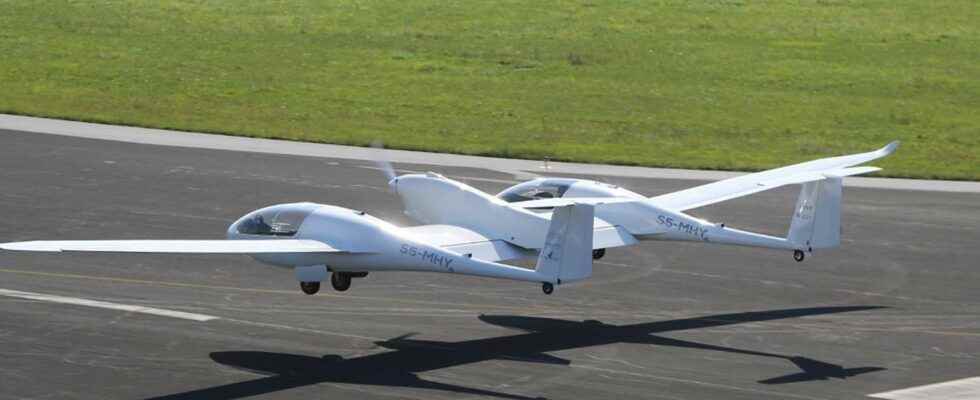You will also be interested
[EN VIDÉO] Blue, grey, yellow and green hydrogen: what’s the difference? Hydrogen is often equated with a color, which depends on how it is produced.
7,230 feet (2,204 meters)! This is the new altitude record for a hydrogen plane. This feat was achieved on April 13 by the German manufacturer H2FLY and its HY4 four-seater aircraft. The aircraft also set a second record, that of the first flight of an airplane at hydrogen between two commercial airports. On April 12, the HY4 traveled 124 kilometers between Stuttgart and Friedrichshafen airports.
H2FLY works on hydrogen systems since 2015, and its HY4 aircraft flew for the first time in 2016. The aircraft features a hybrid system, with an 80 kilowatt electric motor powered by a Fuel cell. The latter uses hydrogen maintained at a pressure of 5,800 PSI (400 bars) and divided into two tanks.
A 40-seat hydrogen plane within a few years
The aircraft is also equipped with lithium-ion batteries which provide additional power during peak consumption, and in particular during take-off. The HY4 has a speed cruising speed of 145 km/h with a autonomy which can reach 1,500 kilometers with a minimum load and optimal conditions.
With this new record, the company wants to start ” the era of zero emission air travel and sustainable “. Based on the performance of its HY4, H2FLY expects to equip a 40-seat Dornier 328 aircraft with a hydrogen engine no later than 2025.” A few years from now “, the manufacturer hopes to be able to transport 40 passengers over a distance of up to 2,000 kilometers.
The HY4, an amazing hydrogen electric plane, has taken flight
Powered by a fuel cell, the HY4 electric aircraft, developed by German researchers, has a range of more than 750 km. This strange-looking four-seater has made its first flight. The objective is to design a 19-seat “zero episode “. Behind this project: Airbus, Siemens and 20 universities…
Article of Jean-Luc Goudetpublished on 06/10/2016
A strange machine took off on September 29, 2016 from Stuttgart airport. This device with two airframes looks like two planes which, like brothers Siamese, would be connected to each other by a common wing, carrying an engine and a propeller. The HY4 makes little noise: the engine, 80 kW, is electric. On takeoff, a phase where consumption is high, it is a lithium-ion battery that supplies the electricity. But in flight, a Fuel celldrawing hydrogen from a tank maintained at low temperature, produces a Electric power by reaction with oxygenair and releases water vapour. Results announced but to be validated: 145 km/h cruising, 200 km/h peak and a range of 750 to 1,000 km.
Certainly theelectric plane is not new. Many builders, big or small, have been trying it for years and we no longer present the expedition Solar Impulse who completed a world tour thanks to theenergy solar. The use of a fuel cell to supply electricity to a aircraft is not new either. In 2007, we presented the SmartFish, a scale model that became “HyFish” once equipped with an electric motor and a fuel cell. The transformation had already taken place in Stuttgart, in the workshops of the DLR, Deutsches Zentrum für Luft- und Raumfahrtan aeronautical research institute.
Hydrogen-electric aircraft, the focus of a major research program
The German engineers persisted. Researchers from the University of Ulm got their hands dirty and the DLR embarked on a vast research program on electric aviation, with Airbus and Siemens as industrial partners and as scientific support the help of 20 universities and research centers of theHelmotz Association. The HY4 is based on a commercial electric aircraft, the Taurus Electro from the Czech company Pipistrel. This Taurus is in fact a “motor glider”, that is to say a glider, with a large wingspan of 14.97 m and a low-power engine (30 kW in cruise, in this case). The team of H2Flywhich is leading this project, brought together two Taurus, to carry the motorization, the fuel cell and the battery, achieving a mass total of 1,500 kg. The process is ingenious and avoided building an aircraft from A to Z, as the team of Solar Impulse.
The result is a four-seater, which is exceptional for an electric aircraft. The final objective is not however to propose a motorglider of leisure. Airbus and Siemens have been working on the subject of electric aviation for several years. Airbus, for example, produced the prototype E-Fanpresented at the last Paris Air Show, studies the fuel cell for its A320 Neo and still claims to be working on the project for a low-capacity transport aircraft. DLR says the same thing in its communicatedestimating that electric motorization would be suitable for small aircraft taxis for short distances, on a regional scale, up to “19 seats”. It will then remain to find the means to produce large quantities of hydrogen, if possible other than with fossil fuel power plants. These planes would then be truly “zero emissions”.
Interested in what you just read?
